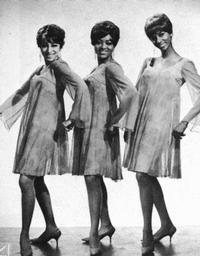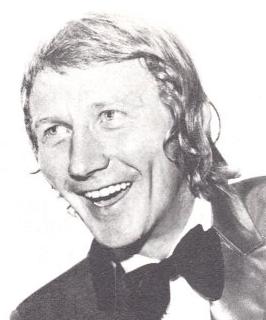Don Gardner - My Baby Likes To Boogaloo b/w Inaugural Malaise
 Marching to Victory
Marching to Victory
"I Popcorn for fun, and I'm second to none" - Lou Courtney
 Marching to Victory
Marching to Victory
 Joe Cuba
Joe Cuba
 The Velvelettes
The Velvelettes
1. My initial exposure to soul music – as a kid in the 70’s – was via oldies radio which has a propensity to overplay a dozen or so painfully obvious Motown cuts, i.e. ‘Stop In The Name of Love’ by the Supremes, 'I Can’t Help Myself (Sugar Pie Honey Bunch)' by the Four Tops, ‘My Girl’ by the Temptations etc. As wonderful as many of these records are, familiarity breeds contempt and by the time I started actively pursuing soul 45s, Motown was low on my list.
2. My tastes in soul, for a long time, ran more toward the grittier southern heat generated by labels like Stax and Goldwax. My Motown-phobia was first conquered in the mid-80’s when my search for the original version of ‘Leaving Here’ (which I first heard by UK mid-60’s R&B giants The Birds) led me to Eddie Holland’s original on a compilation of “rare and hard to find” Motown tracks. It was on this CD that I was first introduced to Shorty Long, Brenda Holloway and the Velvelettes. In the ensuing two decades, my tastes in soul have broadened considerably (especially toward the ‘Northern Soul’ sound which would not exist without Motown) and my knowledge of the depth of the Motown catalog (including Gordy, Tamla, Soul, VIP and other associated labels) has increased considerably. The scales have fallen from my eyes and many, many brilliant records have been revealed. As I said before, one of the groups I was first exposed to via that rarities CD was the Velvelettes. The track on that disc, ‘A Bird In The Hand (Is Worth Two In The Bush)’ became a fixture of my mix tapes, and as time went on I became aware of more brilliant tracks by the group including the storming ‘Needle In A Haystack’ which was an R&B #1 record in 1964, and ‘He Was Really Saying Something’ which I first became aware of via a cover version by Bananarama & Fun Boy Three in the 80’s. The group only released six 45s between 1963 and 1966 (many written or produced by Norman Whitfield). This past summer my father-in-law was gracious enough to acquire a huge lot of old 45s for me and bring them down to NJ for my perusal. As I spent several evenings digging through the boxes, separating the wheat from the chaff, I pulled out anything that I recognized or that looked interesting. One of these was a Velvelettes 45 on V.I.P. that I had never heard of, ‘Lonely Lonely Girl Am I’. At first I didn’t hold out much hope for the record as it had scotch tape on the run in groove and looked kind of poorly taken care of. Fortunately I was able to remove most of the tape and debris, and when I finally dropped the needle on the record I was blown away. This was one of those rare records that reveal themselves as future cornerstones of your personal taste before the first chorus is over. A record so good that I was immediately confounded by an excited mixture of “how could I have missed this record?!?” and “How quickly can I re-cue this record after it finishes?”. Written by Whitfield, Eddie Holland and Eddie Kendricks (and produced brilliantly by Whitfield) ‘Lonely Lonely Girl Am I’ is just over two minutes and eleven seconds of dancefloor soul brilliance. Opening with a fanfare of strings and drums, and a propulsive beat led by a ringing tambourine, the song sports one of the finest melodies in the Motown arsenal, a stunning lead vocal by Carolyn Gill, and a great hook in the chorus. It is simply one of the most remarkable 45s to come out of Detroit in the 1960’s and that it wasn’t a huge hit is mind boggling (at least to me…). Someone at Motown had confidence in the quality of the song. It was first recorded by Jimmy Ruffin in 1964 (as ‘Lonely Lonely Man Am I”), by the Velvelettes in 1965, the Temptations in 1966 and Chuck Jackson in 1968 (though it should be noted that the male versions of the tune are taken at a much slower tempo). The Velvelettes never recorded a full album, though all their official releases (as well as a fair amount of unreleased material) are available on a single disc UK Tamla/Motown “Best Of..” and a deluxe (also a UK release) 2CD set that includes live tracks, alternate takes etc. and is available at Dusty Groove. Buy one of them (or find the 45s) and start dancing.

 Alan Hawkshaw
Library music (see my previous post about Tony Newman’s “Soul Thing”) is a strange – but ultimately rewarding – world, the deep exploration of which is best left to the hardcore aficionados. This is not to say that it cannot be appreciated with glee by dilettantes like myself. That is also not to say that ‘Boogaloo’ by Keith Mansfield and his Orchestra is technically “library” music. While Mansfield was/is one of the genre’s most serious practitioners - and it doesn’t seem unlikely that ‘Boogaloo’ could have been used in an ad or as background for a “swinging discotheque” scene on the telly* – this particular gem was concocted and served up for the listening pleasure of the general public.
‘Boogaloo’ originally appeared on the LP ‘All You Need Is Keith Mansfield’ in 1968 (along with the original version of ‘Soul Thing’). The tune is a swinging, ever so slightly funky exercise in magic, in which Mr. Mansfield waves his wand (baton) and conjures up a glittering slice of the Jet Set, zodiac medallions, Nehru jackets, dry gin, dolly birds etc.
The opening bars seem cribbed from Herbie Hancock’s “Bring Down The Birds” from the ‘Blow Up’ soundtrack (better know to most as the sample source for Dee-Lite’s “Groove Is In The Heart”). The back-up singers drop in along with the drums, and things move along at a nice, breezy pace. Then the flutes and brass come in kicking things up another step, until a horn break, after which things become much more explosively groovy with the addition of none other than Mister Alan Hawkshaw and his mighty Hammond organ.
For those out of the loop of all things Hawkshaw-ian, Alan Hawkshaw (another storied UK studio musician and library cat) was the mastermind behind the organ grooves factory the Mohawks (they of ‘Champ’ fame, another frequently used sample source). Hawkshaw wails on the organ in his inimitable style, with a great cowbell riff cycling in the background.
After his solo begins, the singers and the brass drop back in to bring things full-circle. Hawkshaw riffs on the Hammond along with a flute solo and the record fades out.
In the end, what you’re left with is a serving of stylish perfection. Enough polish and glitz for the lounge heads, enough greasy Hammond for collectors of that particular variety of groove, combined to create a stellar example of the third, heretofore unknown genre of Dancefloor Groovadelics.
If you should happen upon a 45 copy of this gem you will also receive the extra added bonus of a non-LP flipside, the also-quite-groovy (and similarly Hawkshaw laden) ‘Soul Confusion’.
*Discotheque scene - not unlike any late 60's episode of Playboy After Dark– filled not with young mods but older guys, tricked out in upscale Carnaby-esque knockoffs and up to their ruffled collars in much younger ladies, all doing that generic dance that everyone on Laugh-In used to do.
Alan Hawkshaw
Library music (see my previous post about Tony Newman’s “Soul Thing”) is a strange – but ultimately rewarding – world, the deep exploration of which is best left to the hardcore aficionados. This is not to say that it cannot be appreciated with glee by dilettantes like myself. That is also not to say that ‘Boogaloo’ by Keith Mansfield and his Orchestra is technically “library” music. While Mansfield was/is one of the genre’s most serious practitioners - and it doesn’t seem unlikely that ‘Boogaloo’ could have been used in an ad or as background for a “swinging discotheque” scene on the telly* – this particular gem was concocted and served up for the listening pleasure of the general public.
‘Boogaloo’ originally appeared on the LP ‘All You Need Is Keith Mansfield’ in 1968 (along with the original version of ‘Soul Thing’). The tune is a swinging, ever so slightly funky exercise in magic, in which Mr. Mansfield waves his wand (baton) and conjures up a glittering slice of the Jet Set, zodiac medallions, Nehru jackets, dry gin, dolly birds etc.
The opening bars seem cribbed from Herbie Hancock’s “Bring Down The Birds” from the ‘Blow Up’ soundtrack (better know to most as the sample source for Dee-Lite’s “Groove Is In The Heart”). The back-up singers drop in along with the drums, and things move along at a nice, breezy pace. Then the flutes and brass come in kicking things up another step, until a horn break, after which things become much more explosively groovy with the addition of none other than Mister Alan Hawkshaw and his mighty Hammond organ.
For those out of the loop of all things Hawkshaw-ian, Alan Hawkshaw (another storied UK studio musician and library cat) was the mastermind behind the organ grooves factory the Mohawks (they of ‘Champ’ fame, another frequently used sample source). Hawkshaw wails on the organ in his inimitable style, with a great cowbell riff cycling in the background.
After his solo begins, the singers and the brass drop back in to bring things full-circle. Hawkshaw riffs on the Hammond along with a flute solo and the record fades out.
In the end, what you’re left with is a serving of stylish perfection. Enough polish and glitz for the lounge heads, enough greasy Hammond for collectors of that particular variety of groove, combined to create a stellar example of the third, heretofore unknown genre of Dancefloor Groovadelics.
If you should happen upon a 45 copy of this gem you will also receive the extra added bonus of a non-LP flipside, the also-quite-groovy (and similarly Hawkshaw laden) ‘Soul Confusion’.
*Discotheque scene - not unlike any late 60's episode of Playboy After Dark– filled not with young mods but older guys, tricked out in upscale Carnaby-esque knockoffs and up to their ruffled collars in much younger ladies, all doing that generic dance that everyone on Laugh-In used to do.